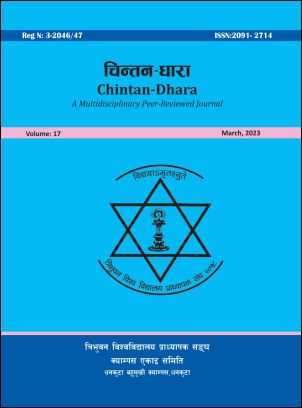प्रेमा शाहका संलग्न स्वकथनात्मक समाख्यानमा वाच्यत्व {Textuality Involved in Prema Shah's Memoiristic Narratology}
DOI:
https://doi.org/10.3126/cd.v17i01.53267Keywords:
आत्मगतअनुभूति (intropection), दृष्टिकोण (approach), पक्षधरता (favourism), समाख्याता (narrator)Abstract
प्रस्तुत लेख प्रेमा शाहका संलग्न स्वकथनात्मक समाख्यानमा वाच्यत्व विश्लेषणमा आधारित छ । आख्यानको संरचना विश्लेषण गर्ने सैद्धान्तिक अवधारणालाई समाख्यानशास्त्र भन्छि । समाख्यानमा वाच्यत्वले समाख्याताको आवाजलाई बुझाउँदछ । समाख्याता स्वयम् पात्रका रूपमा कथासंसारभित्र उपस्थित भएर आफ्नो कथा आफै वाचन गरेको समाख्यानतालाई संलग्न स्वकथनात्मक समाख्यान भनिन्छ । समाख्यानमा समाख्याताले व्यक्त गरेका विचारहरूबाट वाच्यत्व पहिचान गर्न सकिन्छ । यसमा शाहका पहेँलो गुलाफ कथासङग्रहमा सङगृहीत ‘पहेँलो गुलाफ’ र ‘सिउँडीको झ्याङमा’ संलग्न स्वकथनात्मक कथालाई सोद्देश्य छनोट विधिका आधारमा लिई वाच्यत्व निरूपण गरिएको छ । यसमा पुस्तकालय अध्ययन विधिबाट प्राथमिक र द्वितीयक स्रोतका सामग्रीहरू सङ्कलन गरिएको छ । यसमा छनोट गरिएका कथालाई प्राथमिक स्रोत र ती कथासँग सम्बन्धित लेखरचना, अनुसन्धान, समालोचना र सैद्धान्तिक सामग्रीलाई द्वितीयक स्रोत सामग्रीका रूपमा लिई जेराट जेनेट, मिकि बल, रिमोन केनोन, जेनलगायतका समाख्यानाशास्त्रीहरूका वाच्यत्वसम्बन्धी सिद्धान्तलाई पाठ विश्लेषणको आधार बनाइएको छ । यसमा कथाको वाच्यत्वको निरूपणको लागि समाख्याताको आत्मगत अभिव्यक्ति, समाख्याताको दृष्टिकाोण, समाख्याताको पक्षधरता र विषयक्षेत्रको निर्धारण तथा पात्र चयनलाई आधार बनाई कथाहरूको गहन अध्ययन तथा विशलेषण गरी निष्कर्ष प्रस्तुत गरिएको छ । यसमा सन्दर्भसामग्रीको प्रयोगमा ए. पि. ए. पद्धतिको प्रयोग गरिएको छ ।
(The presented article is based on the textual analysis of Prema Shah's memoiristic narratology. The theoretical concept of analyzing the structure of a narrative is called narratology. Vocabulary in narratology (samakhyana) refers to the voice of samakhyana. Self-narrative narration is a narration in which the narrator himself is present in the world of the story as a character and recites his own story. Authorship can be identified from the ideas expressed by the editor in the Samakhyan. The autobiographical stories related to 'Yellow Rose' and 'Siundiko Jhangma' collected in Shah's Pehelo Gulaf Katha Sangrah have been determined based on the purposeful selection method. In this study, materials from primary and secondary sources have been collected through library study method. The selected stories are taken as primary sources and the writings, research, criticism and theoretical materials related to those stories as secondary source materials, the theory of textuality of historians such as Gerrat Janet, Mickey Ball, Rimon Keenon, Zen, etc. have been made the basis of text analysis. In order to determine the textuality of the story, an in-depth study and analysis of the stories have been presented, based on the self-expression of the author, the perspective of the author, the support of the author and the determination of the subject area and the selection of characters. In the use of reference materials. A. P. A. method has been used.)




